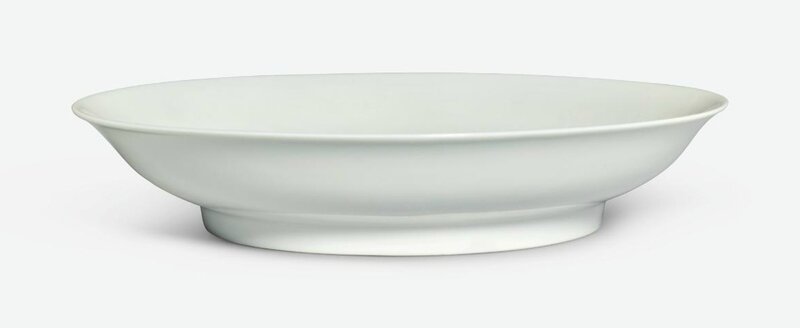A rare anhua-decorated tianbai-glazed dish, Ming dynasty, Yongle period (1403-1424)
Lot 2. A rare anhua-decorated tianbai-glazed dish, Ming dynasty, Yongle period (1403-1424). Estimate 200,000 — 300,000 USD. Lot sold 275,000. Photo: Sotheby's
thinly potted, the gently rounded sides rising to a very slightly lipped rim, decorated around the well in anhua technique with a pair of scaly dragons in pursuit of 'flaming pearls', amidst cloud scrolls, the center with three radiating cloud scrolls, applied overall with a 'sweet white' (tianbai) glaze of warm milky tone, save for the footring left unglazed. Diameter 7 1/2 in., 19 cm
The milky semi-translucent white glaze, combined with the thinly potted body of this dish, reveals the exceptional craftsmanship and quality of materials achieved by potters at Jingdezhen in the early fifteenth century. The cold blue-tinted glazes of the Song dynasty, known as qingbai, developed first into the more subtle, matte and opaque shufu type of the Yuan period, before eventually reaching the superb smooth and pure-white of the Yongle reign. Known as ‘sweet white’ (tianbai), this glaze is described by Nigel Wood in Chinese Glazes. Their Origins, Chemistry and Recreation, London, 1999, p. 66, as consisting almost entirely of glaze stone with little or no glaze ash, which creates the brilliant smooth surface.: The milky semi-translucent white glaze, combined with the thinly potted body of this dish, reveals the exceptional craftsmanship and quality of materials achieved by potters at Jingdezhen in the early fifteenth century. The cold blue-tinted glazes of the Song dynasty, known as qingbai, developed first into the more subtle, matte and opaque shufu type of the Yuan period, before eventually reaching the superb smooth and pure-white of the Yongle reign. Known as ‘sweet white’ (tianbai), this glaze is described by Nigel Wood in Chinese Glazes. Their Origins, Chemistry and Recreation, London, 1999, p. 66, as consisting almost entirely of glaze stone with little or no glaze ash, which creates the brilliant smooth surface.
Numerous fragments of monochrome ‘sweet white’ wares have been recovered from the waste heaps of the Ming imperial kiln site, both in the early and late Yongle strata, which testifies to their popularity at the Yongle imperial court, where the taste for blue and white developed only slowly. The color white was of the utmost importance in Buddhist ritual ceremonies, which the emperor strongly patronized. It has also been suggested that the preference for white wares may have been politically motivated. The color white is associated with filial piety and mourning, and the Emperor’s choice for white may have been intended to provoke a negative reaction to the usurpation of his nephew’s throne (see the catalogue to the exhibition Defining Yongle. Imperial Art in the Early Fifteenth-Century China, The Metropolitan Museum of Art, New York, 2005, p. 35).
A similar dish in the National Palace Museum, Taipei, was included in the Museum’s Special Exhibition of Early Ming Porcelains, Taipei, 1982, cat. no. 69; another is illustrated in Tôyô Tôji Meihin Zuroku/Masterpieces of Chinese and Korean Ceramics in the Ataka Collection. China, Tokyo, 1980, pl. 100; and a third was included in the Min Chiu Society exhibition Monochrome Ceramics of Ming and Ch’ing Dynasties, Hong Kong Museum of Art, Hong Kong, 1977, cat. no. 129. Other related dishes were sold at auction; one from the W.W. Winkworth and the Eumorfopolous collections, was sold twice in our London rooms, 30th May 1940, lot 319, and 19th February 1963, lot 23; another was sold in our Hong Kong rooms, 17th May 1988, lot 38; and a third from the collection of Frederick M. Mayer, was sold at Christie’s London, 24th June 1974, lot 78.
Dishes decorated with dragons and three clouds on the interior are also known in underglaze blue, such as a dish in the Palace Museum, Beijing, included in the Museum’s exhibition Imperial Porcelains from the reigns of Hongwu and Yongle in the Ming Dynasty, Beijing, 2015, cat. no. 26; and another sold in our Hong Kong rooms, 5th November 1997, lot 1366, and again at Christie’s Hong Kong, 27th October 2003, lot 625.

/https%3A%2F%2Fprofilepics.canalblog.com%2Fprofilepics%2F1%2F0%2F100183.jpg)
/https%3A%2F%2Fstorage.canalblog.com%2F03%2F02%2F119589%2F96711876_o.jpg)
/https%3A%2F%2Fstorage.canalblog.com%2F11%2F31%2F119589%2F94773502_o.jpg)
/https%3A%2F%2Fstorage.canalblog.com%2F20%2F83%2F119589%2F94772815_o.jpg)
/https%3A%2F%2Fstorage.canalblog.com%2F26%2F72%2F119589%2F75604929_o.jpg)
/https%3A%2F%2Fstorage.canalblog.com%2F59%2F60%2F119589%2F26458628_o.jpg)




/http%3A%2F%2Fstorage.canalblog.com%2F38%2F01%2F119589%2F129461372_o.jpg)
/http%3A%2F%2Fstorage.canalblog.com%2F77%2F10%2F119589%2F129137638_o.jpg)
/http%3A%2F%2Fstorage.canalblog.com%2F87%2F78%2F119589%2F129132376_o.jpg)
/http%3A%2F%2Fstorage.canalblog.com%2F04%2F08%2F119589%2F129104409_o.jpg)